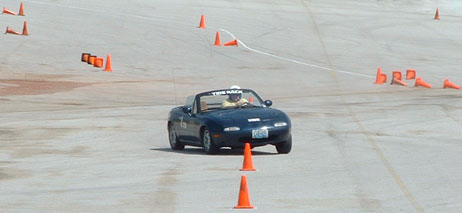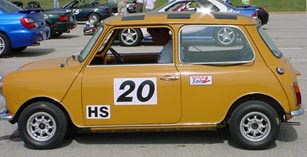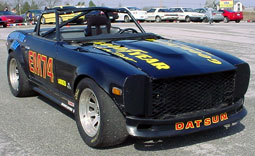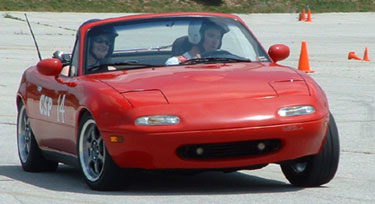Start at the Beginning
What is Autocrossing?
An autocross is a test of handling and driving skill on a temporary race course marked by cones. Usually held in a large parking lot or an airport tarmac, drivers race one at a time against the clock to see who can negotiate the course the fastest without hitting any cones. Autocrossing is the most affordable, accessible outlet of motorsports in the country with a following in the tens of thousands nationwide. The vast majority of all these events are sanctioned by regions of the Sports Car Club of America (that's us) under the name "Solo." For our purposes, "autocross" and "Solo" are interchangeable.

Is it Safe?
Solo is designed to be a legal, low-risk competition against the clock at speeds typically from 25-65 MPH. Rather than emphasize raw speed, autocross events focus on an intense driving experience that rewards precision driving in a twisty course. The potential for damage, wear, and tear is kept to a minimum, allowing a variety of drivers and cars to participate at low cost. For $20 to 35, the family station wagon can be a racecar on Sunday and carry the groceries on Monday.
Check the basic requirements on our Solo Information page, and show up. That's it!
![]()
Get Ready
Prepare for Weather
A little rain doesn't scare autocrossers. Downpours and lightning can halt an event, but racing will continue during a light rain or wet course. Wear close-toed shoes and dress in layers, and don't forget winter gear, shorts, umbrellas, or sunscreen as the forecast demands. Water will be available, but bringing extra never hurts.
A lunch break may be nothing more than grabbing a snack on the run, or it may be a 30-minute break if the day is going smoothly. Prepare accordingly.
Prepare your car
Autocrossing is mainly hard on tires. Street tires typically need a lot more air than normal to prevent sidewall rollover and flex, often an additional 10psi or more. A quality air gauge is a good investment. Autocrossing doesn't typically see speeds high enough to overheat or fade brakes. A set of regular brake pads with a safe amount of pad material left will be fine. If it has been a while since you flushed or bled your brake fluid, now is good time to check on that.
A regularly maintained car should have no trouble surviving an autocross, which makes it great for trying it out in the family sedan.
![]()
Your First Event
When You Get There
At the entrance station, sign the safety wavier and get an armband. If you have guests joining you, make sure they also stop here to sign the waiver, even if they are not competing. We have a Novice handout (view PDF online here) and Spectator handout (view PDF online here) available at the gate to guide you from there.
Find an unoccupied spot to park, and unload anything not safely secured to the car. This usually includes the spare tire, jack, floor mats, subwoofer, or anything loose that could move around while autocrossing. Once you have cleaned out your car, move your car to the tech inspection line or tech area. Open the hood and trunk, and a tech inspector will check your car and initial a small tech sticker (tech inspection details here). Then you can park and go to the trailer to register. If you pre-registered online via the link in the event announcement online, your information is already in the system and the next part will be a breeze.
Registration will ask you for your driver's license, SCCA card (if an annual member), and collect your entry fee. If you are not a SCCA member, you will fill out a SCCA weekend membership form good for five days of club membership and a discount on annual membership. Here they will also enter your class and number in the timing computer, and sign you up for a work assignment. No one likes work, but someone has to keep the event running while the other half race. Watching cars on course as a corner worker is a very good way to see how to go faster. If you mention that you are new to the sport, registration can usually pair you with a more experienced corner worker.
After registration is an excellent time to go walk the course and get to know the path you will be driving. If in doubt, follow others around the course and don't hesitate to ask for directions. Events usually have an experienced member lead a novice course walk around mid-morning, so listen for announcements.

Competition Time
A drivers' meeting is held a few minutes before the start of competition, and all drivers must attend. The event chairman will cover announcements, the day's schedule, number of runs, standards of conduct, and how to work a corner station. Once the meeting is over, you will either be preparing to race or work, depending on how you were signed up at registration. If it is your "heat" to race, pull your car to an empty grid spot. Cars are staged here between runs, and the grid chief will work down the line of cars until it is your turn. Be ready with helmet and seatbelt in place. The starter will hold you until it's your turn, and then it's up to you! When you're done and pulling off course, remember to slow it back down to a walking pace as you pull back to your grid spot. If you are using a loaner helmet, don't forget to return it after every run so that they are available to share.

End of the Day
At the end of all heats, extra help is always appreciated. Cones need to be stacked, driven back to the trailer, and loaded up. After that, results are announced and trophies are given to the top third in class.
Remember to get back into "street" mode at the end of the day. Burnouts, donuts, street racing, and speeding near the site attract unwanted attention. Please help us keep our site!
![]()
About Classing
What is it about?
All vehicles are grouped with other cars with similar levels of performance and modification for purposes of timing and scoring. Here is rough outline of the types of Solo classes:
- Street - dampers, cat-back exhaust, one swaybar, and street tires are the only notable performance upgrades allowed. Tires must be 200 treadwear or greater.
- Street Touring - many popular suspension and engine bolt-ons, and street tires with a wear rating of 200 or greater.
- Street Prepared - suspension, any DOT race tires, and minor/moderate engine upgrades
- Prepared - extensively upgraded vehicles
- Modified - full-on racecars and extensively modified production-based racecars
- Street Modified - street cars with engine swaps and modifications
- Classic American Muscle - Pro-Touring style front-engined, RWD American vehicles with engine swaps or upgrades.
 H-Street Mini |
 E-Modified Datsun |
How is my car classed?
The full SCCA Solo Rulebook is online in Adobe Acrobat (.PDF) format, and can be downloaded and viewed with Acrobat Reader. The classing hierarchy can be confusing at first, so feel free to log onto the OMR Forums and ask one of our regulars to steer you in the right direction.
For a new autocrosser, the main thing to remember is to learn and have fun. "Competitiveness" can wait, so don't worry about who or what is in your class.
 |
Your car will need numbers and class letters on the side of the car so that course workers can identify you. The SCCA requirement is numbers 8" tall with 1.25" stroke (thickness) and class letters 4" tall with 0.75" stroke. You can make visibly large numbers and letters out of painter's tape in a contrasting color. However, tape can be hard to see, so we recommend buying a magnetic number set or a sheet of magnetic material (or static cling for composite bodies). |
![]()
Learning Curve
Course Walking
Walking the course is an often underestimated part of learning the sport and getting faster. Always err on the side of arriving early so you have plenty of time to walk the course multiple times. In the beginning, just knowing where it goes seems like a challenge. Don't hesitate to ask someone in the know about a confusing section.
As a rule of thumb, if you can't run the course in your mind or the draw the general path on a piece of paper, you should walk it again. Help your memorization by narrowing down the sea of cones to just the important ones. Cones just set boundaries or provide direction, so pick out which ones you want to be looking for when you're driving at speed.
Experienced autocrossers use the course walk to plan how and where they are going to place the car. Behind the wheel, they are looking ahead to key cones and fine-tuning the line they planned during their walk. This is easier said than done, but it comes with practice.
For now, taking the time to know your way around will make the task of driving easier.

Getting the Most Out of It
Your first time out, you could be one of the slowest drivers at the event. Don't worry, though. We were all there at some point, and remember it well. You will see your biggest improvement during your first few events, chopping off seconds with every run.
Autocrosses are social events, a very open fraternity of car nuts. When you are not driving, there is plenty of time to meet new people, BS, and learn from others. Armchair racing can be as important as the actual racing in some company.
Autocross for fun, not to be the best. It takes years of experience to be among the most competitive in the sport. Enjoy the opportunity to drive your car on the limit and improve your skills.
![]()
Going Faster
Seat Time
Exposure pays, whether behind the wheel or riding as passenger. OMRSCCA allows one passenger with helmet during autocross runs, so use it to your advantage. Most drivers are willing to share their tips and knowledge, unless they are on their last run or sitting in the car with helmet in place. If you have time between runs, you might find a ride with someone more experienced. Taking or being a passenger is a good way to gain insight on how to improve your runs.
The more seat time, the better. Autocross schools, as held by some SCCA regions and private schools like Evolution, are an effective route to better driving. Prices vary widely, but experienced instruction is valuable no matter what. Traveling to other regions' events on off weekends and attending higher-level events (described below) is also great for experience.

Tires
Other than driver skill, tires are the single most important investment you can make for autocrossing. Many drivers have a second set of wheels and tires just for competition use. In the Street category, the wheels you use must be the same width as stock, and be within +/- 0.25" of the stock offset and +/- 1" diameter. Street Touring is another category with width limits. Check the rules before you make an investment.
Relatively affordable Summer performance tires such as the Dunlop ZII, BFGoodrich Rival, and Hankook RS-3 are common in Street and Street Touring, categories requiring a minimum tread wear rating. They are also popular among casual autocrossers in classes where more expensive, faster-wearing race tires are allowed. Tires like these are a good place to start for beginning autocrossers.
In the Street Prepared and Street Modified classes, DOT-rated race tires are allowed. They are closer to a full racing slick, but have radial construction and minimal tread grooves to meet regulations for street legality. They are hardly a tire for street use, rather a tire designed with autocrossing or road racing specifically. You will often see experienced drivers using them to their advantage.
![]()
The Next Level
Solo Event Types
Regional - Our regular monthly events are at the "regional" level. OMR autocrosses are among hundreds of Solo events held by SCCA regions across the country.
Divisional - SCCA regions are grouped into one of eight divisions, and OMR is in the Midwest Division (a.k.a. MiDiv). Every year, a series of regions host two-day inter-regional Solo events leading to a divisional points championship. Typically held at larger sites, they attract SCCA members from all around that part of the country. These offer a larger, more competitive field of drivers while maintaining much of the laid-back social atmosphere of a regional event.
National - the best drivers with the most competitive cars come together at large events administered by the SCCA national office. About ten National Tour events are held at sites around the country, bringing in competitors from great distances. The biggest autocross in the nation is the week-long Solo National Championships typically held in the Midwest during September. High turnouts in all classes require clockwork operation, fast coursework, and detailed timing and scoring. Trophy positions are fought among top drivers with cars prepared to the extent of the rules, but any SCCA member is allowed to compete and enjoy the excitement.
PAX Explained
You might hear about PAX, also know as the Racers Theoretical Performance index. It's not an official SCCA system, but it's used by OMR to give out a couple of extra trophies to the best drivers (in theory) at each event. It uses math developed by a panel of super-smart national autocross experts to take the car's performance out of the equation.
Try this example: a driver in an unmodified Mini Cooper (H-Street) has a best time of 60 seconds, while a driver in a more potent Datsun racecar (E-Modified) ran the same course in 54 seconds.
Both classes have a number on the PAX index chart:
HS = .792
EM = .887
Notice how a slower class has a smaller number? When you multiply it by the actual raw time, you get the "indexed" time.
HS Mini: 60.000 x .792 = 47.452
EM Datsun: 54.000 x .887 = 47.898
Advantage: Mini. The indexed time takes the performance of the car into consideration. In theory, the driver of the Datsun would have needed to pull a 53.48 second run to match the driving skill of the Mini's pilot on that course. Though PAXing not 100% accurate, it's based on years of competition at major events around the country. PAX times give a relative sense of who are driving their cars to the fullest potential.
![]()
You may hear more advice than you can absorb talking to other autocrossers. Remember that safely having fun is the first priority, followed by improving the driver. Don't worry as much about performance upgrades until you begin learning how to get the most out of your car. See you at the next event!

